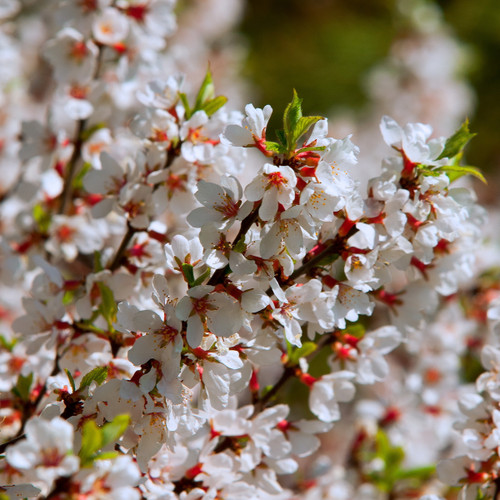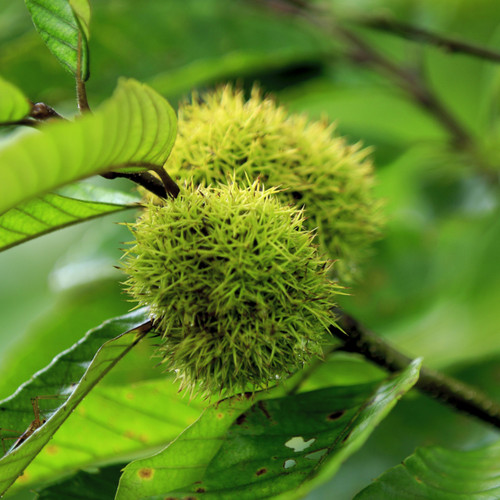Cannot Ship To:AK,CA,HI
Please Read Our Store Policies HERE Before You Order!!
Introduction:
The Choke Cherry Tree (Prunus virginiana) is a hardy, deciduous tree or shrub known for its fragrant white flower clusters and small, tart, dark purple berries. Native to North America, the Choke Cherry is a popular choice for naturalized areas, wildlife gardens, and hedges. While the berries are too sour to eat fresh, they can be used to make jams, jellies, and syrups. The tree also provides excellent habitat and food for birds and other wildlife.
Plant Summary:
- Size: Grows to a height of 20-30 feet with a spread of 15-25 feet.
- Foliage: Glossy green, oval-shaped leaves turn yellow or red in the fall.
- Flowers/Fruit: Clusters of fragrant white flowers in spring, followed by small, dark purple berries.
- Growth Habit: Upright, spreading habit with multiple stems or a single trunk.
- Sunlight: Prefers full sun to partial shade.
- Soil: Thrives in moist, well-drained soils but tolerates poor, dry soils.
- Hardiness: Hardy in USDA Zones 2-7.
- pH Level: Prefers slightly acidic to neutral soils (pH 5.5 to 7.0).
- Pruning: Prune in late winter to shape the tree and remove dead or damaged branches.
- Pests/Diseases: Susceptible to black knot, aphids, and tent caterpillars.
Pollination:
The Choke Cherry Tree is self-pollinating, meaning it does not require another tree to produce fruit. Pollinated primarily by bees and other insects, the fragrant white flower clusters bloom in spring and attract beneficial pollinators to the garden. The small, dark purple berries that follow in summer are a valuable food source for birds and wildlife. While self-fertile, planting multiple trees can improve fruit production.
Key Benefits:
- Produces small, tart berries that can be used in jams, jellies, and syrups.
- Fragrant white flowers attract bees, butterflies, and other pollinators.
- Provides food and habitat for birds and other wildlife, supporting local ecosystems.
- Hardy and adaptable to a wide range of soil types, including poor or dry soils.
- Beautiful fall foliage adds seasonal color to the landscape.
Care Instructions:
- Light: Prefers full sun to partial shade for optimal growth and fruit production.
- Water: Keep soil consistently moist, especially during dry periods.
- Soil Type: Thrives in well-drained soils but adapts to a variety of soil types, including poor soils.
- Pollination: Self-pollinating, though planting multiple trees improves yields.
- Growth Rate: Fast-growing, reaching maturity in 10-15 years.
- Max Height/Width: Reaches 20-30 feet in height and 15-25 feet in width.
- Pruning: Prune in late winter to remove deadwood and shape the tree.
Why You'll Love It:
The Choke Cherry Tree is a versatile and resilient tree that provides both beauty and practical benefits. Its fragrant spring blooms attract pollinators, while its tart, dark purple berries are perfect for making jams, jellies, and syrups. The tree also provides valuable habitat and food for birds and wildlife, making it an excellent choice for naturalized areas and wildlife gardens. Its adaptability to a variety of soil types and growing conditions makes it a reliable choice for even the most challenging landscapes.
Planting Tips:
Plant your Choke Cherry Tree in early spring or fall in a sunny location with well-drained soil. Dig a hole twice as wide as the root system and plant at the same depth it was growing in the nursery. Water thoroughly after planting and mulch around the base to retain moisture and suppress weeds. Regular watering during the first few years will help establish a strong root system and promote healthy growth.
Shipping Details:
Your Choke Cherry Tree will be shipped as a bare root plant, carefully packaged to ensure it arrives in optimal condition. Bare root plants are shipped during dormancy to promote successful transplanting and establishment in your landscape.
11 Reviews Hide Reviews Show Reviews
-
great trees
Received 2 choke cherries and 2 mountain ash--and they are all leafing out nicely. Very healthy trees! Arrived nicely packaged.
-
Chokecherry tree
Company was so great to work with. The plants arrived in excellent condition and are growing like weeds!
-
Chokecherry tree
The trees came in excellent condition. Wonderful customer service!
-
Good condition goods. Very pleased.
Corms are my error. The two cherry trees were in excellent condition due to good packaging and choice of stock
-
Good condition goods. Very pleased.
Some lily corms had grown oolong, and some stalks broke off when unpacking.
-
Choke Cherry Trees
Very healthy trees, packed excellently. Best I have ever received by mail. Thank You!!
-
Great tree
The tree arrived well-packaged. I planted it per the instructions and it's already showing buds 2 weeks later. I also appreciated the quick response when I had a question.
-
Choke Cherry Tree
Was surprised when they arrived on how well they were taken care of and they already have leaves on them after a week of receiving them.
-
chokecherry tree
Arrived nice and tall and plump. Packaged well and ready to plant. Shot up to 5 or 6 feet tall first season. Looking forward to what it's second season here will hold.









